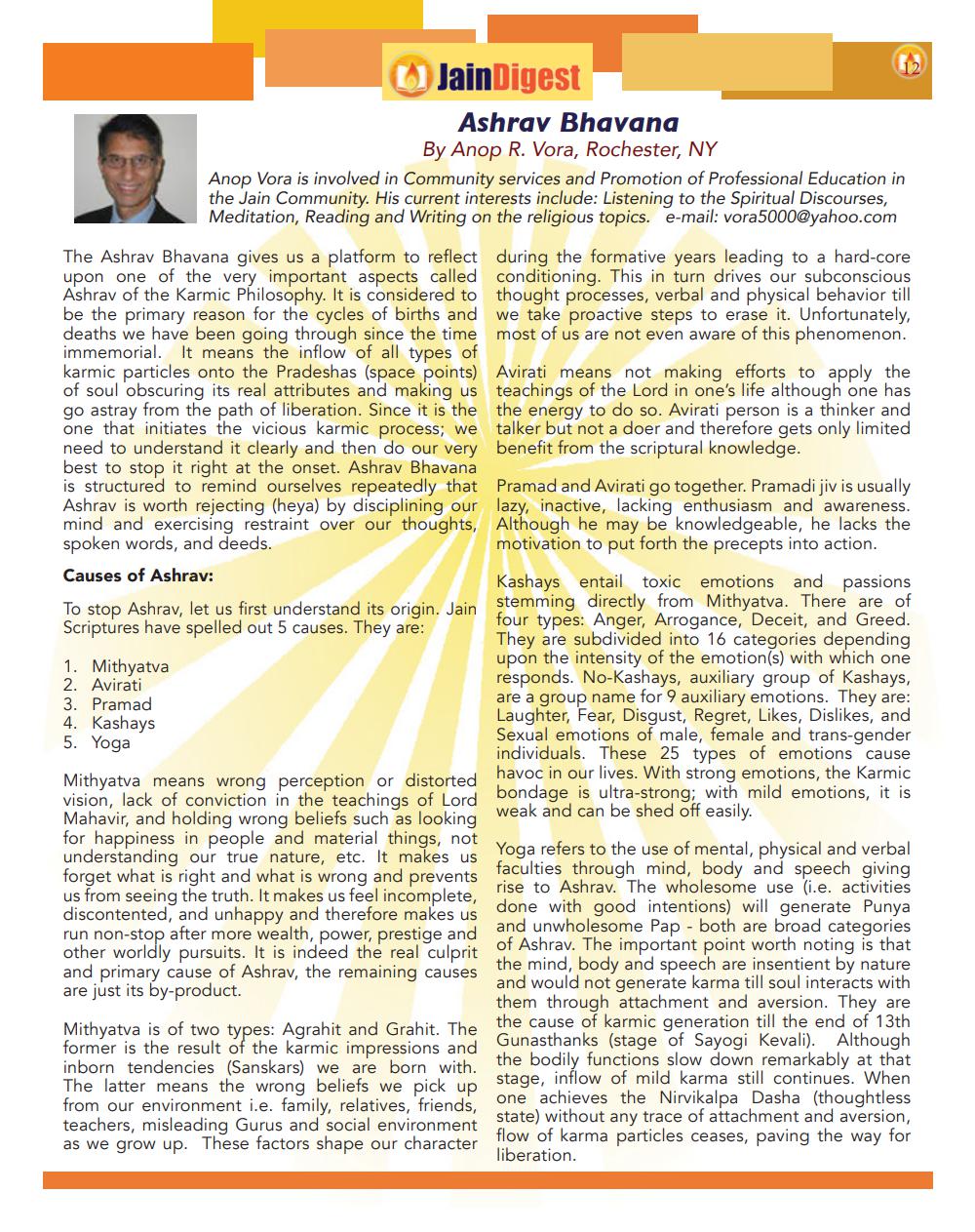________________
JainDigest
Ashrav Bhavana By Anop R. Vora, Rochester, NY
The Ashrav Bhavana gives us a platform to reflect upon one of the very important aspects called Ashrav of the Karmic Philosophy. It is considered to be the primary reason for the cycles of births and deaths we have been going through since the time immemorial. It means the inflow of all types of karmic particles onto the Pradeshas (space points) of soul obscuring its real attributes and making us go astray from the path of liberation. Since it is the one that initiates the vicious karmic process; we need to understand it clearly and then do our very best to stop it right at the onset. Ashrav Bhavana is structured to remind ourselves repeatedly that Ashrav is worth rejecting (heya) by disciplining our mind and exercising restraint over our thoughts, spoken words, and deeds.
Causes of Ashrav:
1. Mithyatva
2. Avirati
Anop Vora is involved in Community services and Promotion of Professional Education in the Jain Community. His current interests include: Listening to the Spiritual Discourses, Meditation, Reading and Writing on the religious topics. e-mail:
[email protected]
To stop Ashrav, let us first understand its origin. Jain Scriptures have spelled out 5 causes. They are:
3. Pramad
4. Kashays 5. Yoga
Mithyatva means wrong perception or distorted vision, lack of conviction in the teachings of Lord Mahavir, and holding wrong beliefs such as looking for happiness in people and material things, not understanding our true nature, etc. It makes us forget what is right and what is wrong and prevents us from seeing the truth. It makes us feel incomplete, discontented, and unhappy and therefore makes us run non-stop after more wealth, power, prestige and other worldly pursuits. It is indeed the real culprit and primary cause of Ashrav, the remaining causes are just its by-product.
Mithyatva is of two types: Agrahit and Grahit. The former is the result of the karmic impressions and inborn tendencies (Sanskars) we are born with. The latter means the wrong beliefs we pick up from our environment i.e. family, relatives, friends, teachers, misleading Gurus and social environment as we grow up. These factors shape our character
during the formative years leading to a hard-core conditioning. This in turn drives our subconscious thought processes, verbal and physical behavior till we take proactive steps to erase it. Unfortunately, most of us are not even aware of this phenomenon.
Avirati means not making efforts to apply the teachings of the Lord in one's life although one has the energy to do so. Avirati person is a thinker and talker but not a doer and therefore gets only limited benefit from the scriptural knowledge.
Pramad and Avirati go together. Pramadi jiv is usually lazy, inactive, lacking enthusiasm and awareness. Although he may be knowledgeable, he lacks the motivation to put forth the precepts into action.
Kashays entail toxic emotions and passions stemming directly from Mithyatva. There are of four types: Anger, Arrogance, Deceit, and Greed. They are subdivided into 16 categories depending upon the intensity of the emotion(s) with which one responds. No-Kashays, auxiliary group of Kashays, are a group name for 9 auxiliary emotions. They are: Laughter, Fear, Disgust, Regret, Likes, Dislikes, and Sexual emotions of male, female and trans-gender individuals. These 25 types of emotions cause havoc in our lives. With strong emotions, the Karmic bondage is ultra-strong; with mild emotions, it is weak and can be shed off easily.
Yoga refers to the use of mental, physical and verbal faculties through mind, body and speech giving rise to Ashrav. The wholesome use (i.e. activities done with good intentions) will generate Punya and unwholesome Pap - both are broad categories of Ashrav. The important point worth noting is that and would not generate karma till soul interacts with the mind, body and speech are insentient by nature them through attachment and aversion. They are
the cause of karmic generation till the end of 13th Gunasthanks (stage of Sayogi Kevali). Although the bodily functions slow down remarkably at that stage, inflow of mild karma still continues. When one achieves the Nirvikalpa Dasha (thoughtless state) without any trace of attachment and aversion, flow of karma particles ceases, paving the way for liberation.
